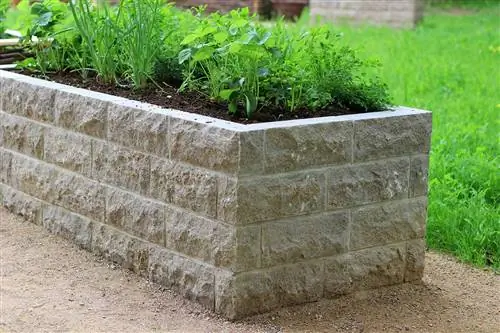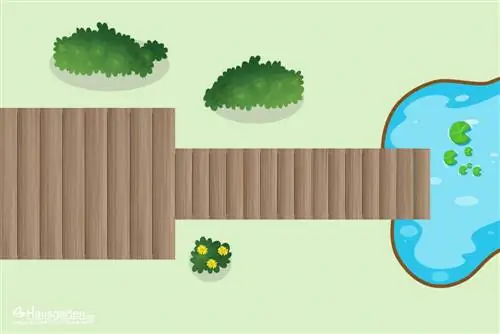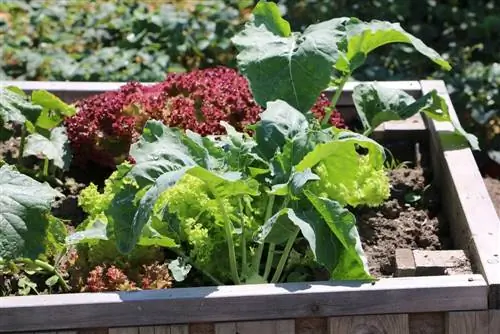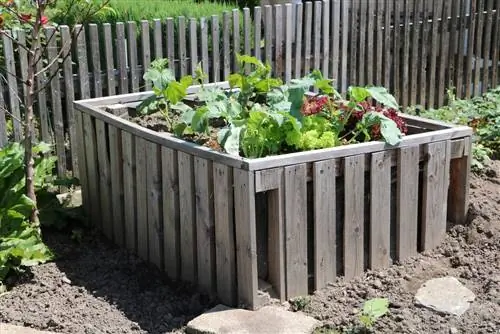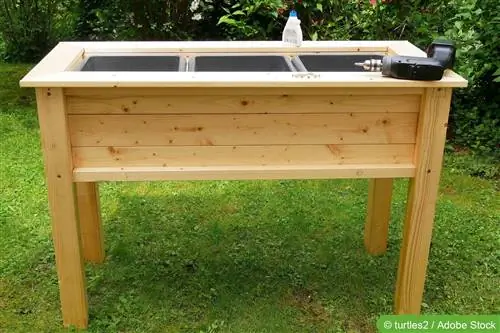- Author admin [email protected].
- Public 2023-12-17 03:39.
- Last modified 2025-06-01 06:48.
If a pinching back makes gardening torture, a raised bed solves the problem. Resourceful home gardeners have discovered Euro pallets for practical wooden construction. Sowing, weeding and harvesting are done comfortably at table height. The options range from mini herb beds for the balcony to mobile raised beds to large vegetable beds for the whole family. Browse the 3 best building instructions for a raised bed made of wooden pallets here.
What are wooden pallets?
Wooden pallets are an important component in the transport of goods across Europe. Constructed as a standardized four-way pallet, the wooden platforms can be loaded from any side and picked up by forklifts. As a rule, they are made of pressure-treated pine wood, more rarely of hard or soft wood.
The common Euro pallet - known in technical jargon as a Europool pallet - has a floor area of 0.96 m². This corresponds to the dimensions of 1,200 mm length x 800 mm width x 144 mm height. Depending on the moisture content of the wood, the weight is between 20 and 24 kg. A classic wooden pallet consists of 11 boards and 9 blocks assembled with 54 screw nails and 24 hammer nails.
The boards have bevels to make maneuvering and threading the forks easier. The larger industrial pallets are 200 mm wider and weigh up to 35 kg. At 10.5 kg, the Düsseldorf pallet is the lightest among wooden pallets and measures 800 mm x 600 mm. A cross-border exchange system ensures that the transport pallets can be used efficiently throughout Europe. Since pallets regularly fall out of the exchange system, they have become of interest to do-it-yourselfers for building furniture, flower boxes and raised beds. Discarded wooden pallets can be purchased from transport companies for little money. Hardware stores and garden centers are now offering new, unused pallets.
Herb raised bed made of pallets - entry-level model
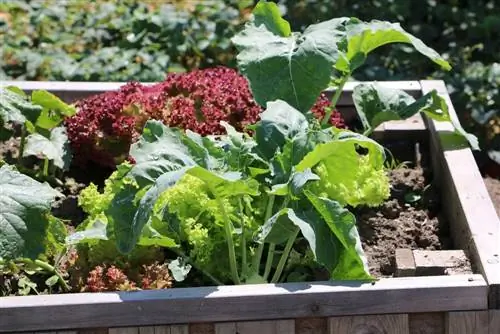
In a trendy wooden look, the herb bed made of pallets is a great eye-catcher in the front garden and on the balcony. A positive side effect is that the herbal plants are at a safe distance from leg-lifting dogs, nibbling cats and voracious snails. The following building instructions offer home gardeners the best opportunity to successfully try out an entry-level model.
Material and tool requirements
- 1 x wooden pallet
- 6 x Mini Plastic Flower Box (300mm x 110mm x 110mm)
- 1 x wooden slat (4,000 mm x 48 mm x 24 mm)
- 1 x screen printed plywood panel (2,500 mm x 1,200 mm x 21 mm)
- 24 x Screws (3.5mm x 35mm)
- 4 x screws (4.5mm x 60mm)
- Impregnation with the “Blue Angel” quality seal
The tools required are limited to 1 drill with bit and wood drill as well as a chisel and brush.
Construction instructions
Before you start assembling the herb raised bed, the wooden panels and the slats are cut to size: Screen-printed plywood panels: 6 pieces each 400 mm x 100 mm x 21 mm and the wooden slats: 2 pieces at 600 mm. How to proceed:
- Remove the second and fourth boards from the wooden pallet with the chisel
- A total of 6 plant compartments are created
- Pre-drill the 6 screen-printed plywoods and attach them from below as bases for the compartments with the 3.5 x 35 mm screws
- Screw the two 600 mm long slats on the right and left as feet with 4.5 x 60 mm screws
- Screw the slats so that they protrude equally on both sides
- Paint all wooden parts with impregnation
Place the flower boxes in the plant compartments and fill them with herb soil. As an alternative to the plastic boxes, you can cover the compartments with pond liner, which you staple to the wooden edges.
Tip for the finishing touches
Even hobby gardeners with many years of experience puzzle over the name of some herbs. By decorating the raised bed with stylish nameplates made from chalkboard paint, you can put an end to the botanical guessing game. Specifically, it is a liquid paint that hardens within 24 hours. Similar to a school blackboard, each sign can be wiped clean and written on again and again with chalk. This is how it works:
- Sand the wood smooth in the designated places
- Mark the painting surface with masking tape to prevent blurred edges
- Apply undiluted blackboard paint with a brush or paint roller and let it dry
You can optimize the decorative effect by framing the board signs with rustic hemp ropes. Once the chalkboard paint has dried, attach the ropes using all-purpose glue.
Raised bed made of 4 Euro pallets

The following construction instructions made it into the top 3 because they are easy to implement even for those with gross motor skills. The result is a raised bed worth seeing that you can plant to your heart's content, not just indoors. In the outer frame, herbs, flowers and small vegetable plants also find the ideal conditions for vital growth. How to proceed correctly step by step:
Material and tool requirements
- 4 x wooden pallets
- 12 x brackets with screws
- Screen printed plywood panels
- 96 screws (3.5mm x 35mm)
- Pond Liner
- Vole wire
- Tacker with staples
- Jigsaw
- Inch rule
- Carpenter's pencil
- Scissors or cutter
- Drilling machine
- Wood impregnation without solvents (Blue Angel)
- Brush
We recommend purchasing new wooden pallets that have received IPPC treatment. These products have been heat treated in a drying chamber to protect them from wood pests. When it comes to used Euro pallets, it is no longer possible to determine whether they came into contact with pollutants that could be transferred to the plants in the raised bed.
Construction instructions
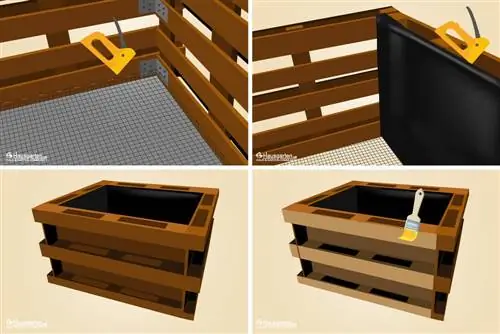
The ground is prepared in advance at the intended location. Please dig out any existing turf to a depth of 10 cm. Then lay out the soil with vole wire so that the wire extends about 10 cm beyond the edge of the finished raised bed. Proceed as follows:
- Put the 4 pallets together horizontally and flush to form a square
- The bottoms of the pallets face outwards
- Screw each corner with 3 angles (top, middle and bottom)
- Line the inner walls with pond liner and staple them firmly
A total of 24 plant compartments have been created on the outside, which are also used for growing herbs and vegetables. Use the ruler to measure the bottom size of the compartments. Then use the jigsaw to cut the plywood panels accordingly and screw them together with the 3.5 x 35 mm screws. Use pond liner to line the plant compartments. To protect against waterlogging, perforate the film in several places before adding potting soil. Instead of lining the compartments with foil, place mini plastic flower boxes on the floors.
Tip:
A place with a north-south orientation is the ideal location for a raised bed in the garden. Thanks to this location, the plants also benefit from warming rays of sunshine in spring and autumn.
Tips for filling
In order for the self-built raised bed made of wooden pallets to produce a rich harvest, it is important to fill it correctly. We have summarized the most important key data for you below:
- First layer: branches, twigs, remnants of pruning
- Second layer: chopped, half-rotted plant residues
- Third layer: mature compost
- Fourth layer: garden soil, leaf mold or humus
This composition makes it clear that the material becomes finer from bottom to top. It is important to note that the layers are, if possible, the same thickness at 20 to 25 cm.
Mobile raised bed for terrace and balcony

If you like gardening on the terrace and balcony, you don't have to forego the comfort of a raised bed. Since this variant lacks direct access to the ground, good drainage is particularly relevant. The classic earth layering is usually omitted. To ensure that the weight is within a tolerable range, commercially available plant soil is used as filling. A stable substructure is nevertheless essential. How to build a mobile raised bed yourself:
Material and tool requirements
- 1 Euro pallet
- 1 wooden panel, 1,200 mm x 800 mm x 6 mm as floor
- 3 attachment frame
- 4 wheels with fastening material (ideally 2 mobile and 2 fixed)
- Garden fleece or pond liner
- Scissors or cutter
- Spax screws
- Cordless screwdriver or drill
You can purchase matching wooden attachment frames for Euro pallets ready-made. With dimensions of 1,200 mm x 800 mm x 200 mm, 3 frames are enough for a mobile raised bed with a back-friendly height of 85 cm. Thanks to galvanized steel hinges, each attachment frame can be folded and can therefore be transported flat and space-saving. Since the hinges protrude in the lower area, they can be placed on the wooden pallet and inside each other without any additional accessories.
Construction instructions
In the first step of assembly, place the wooden panel on the 5 boards of the Euro pallet to screw it together as a base using the spax screws. Then drill small holes in various places so that excess water can drain away and waterlogging does not form. This is how it continues:
- Screw the 4 wheels onto the bottom of the wooden pallet
- Turn the wooden pallet over again and block the wheels with small wooden wedges
- Place the attachment frames on the Euro pallet
- Line the inner walls with garden fleece or pond liner and staple them firmly
To protect the base plate from moisture, there are 2 options to choose from: a coat of weatherproof wood stain or covering with perforated film. Unless the mobile raised bed is in a rain-protected location, the outer walls should also be impregnated with wood stain.
Cover for an early start to the season - collection of ideas

If you expand your new raised bed with a cover, the gardening season starts in February and March. You can sow early lettuce, lettuce and radishes early in the year as long as the seeds are protected from frost and moisture. At the same time, the time window for cultivation is extended until September and October if an attachment is available. Winter vegetables, such as kale or leeks, grow excellently in raised beds and enrich the menu with fresh vitamins when nothing grows outdoors anymore. Get inspired by the following raised bed cover ideas:
Window with wooden frame
Disused glass windows with wooden frames harmonize perfectly with a raised bed made of wooden pallets. Look around at flea markets or ask at the recycling center or demolition company. In these places you can get old house windows for little money. If you screw the windows onto the frame of the raised bed with hinges, you can easily open and close the cover at any time.
Double-wall plate
A 4 to 6 mm thick double-wall sheet can be transformed into a protective cover for your raised bed in just a few simple steps. Place the edges of the panel between wooden slats that you screw together to form a frame. You connect the cover and raised bed with hinges. Alternatively, simply nail 3 old leather straps to be able to open and close the double bar cover. 2 leather straps serve as a hinge replacement, 1 strap serves as a handle. A knotted stone acts as a counterweight on the leather strap handle to prevent strong winds from lifting the plate.
Polytunnel
Under a polytunnel, your vegetable plants will thrive in the raised bed, well protected from the effects of the weather. The construction is very easy with round rods made of spring steel, over which you pull a weatherproof greenhouse film. Loose brackets for polytunnels are available for purchase at hardware stores, which already have the appropriate loops for secure attachment. This raised bed cover option scores points with the advantage of a flexible height design, so that you can also prefer higher growing plants under the protection in spring.


